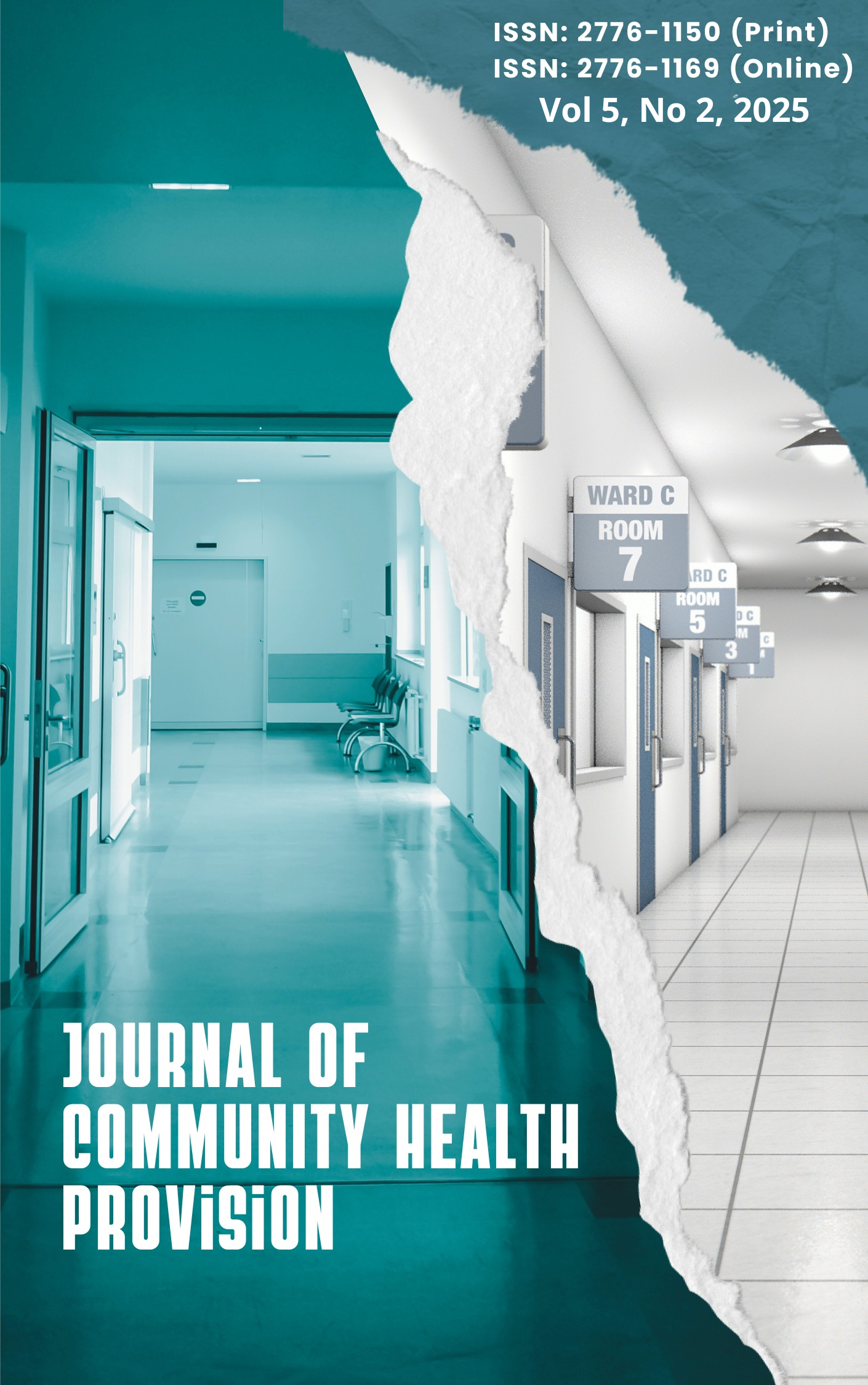Analysis of Occupational Safety and Health Management System Implementation (SMK3) at PT. PLN (Persero) UP3 South Makassar
Main Article Content
Abstract
Article Details

This work is licensed under a Creative Commons Attribution-ShareAlike 4.0 International License.
References
Adams, E. M. (2016). Human rights at work: Physical standards for employment and human rights law. Applied physiology, nutrition, and metabolism, 41(6), S63-S73. https://doi.org/10.1139/apnm-2015-0552
Aditya, I. A., Haryadi, F. N., Haryani, I., Rachmawati, I., Ramadhani, D. P., Tantra, T., & Alamsyah, A. (2023). Understanding service quality concerns from public discourse in Indonesia state electric company. Heliyon, 9(8).
Anggraini, T. S., & Pratama, A. S. P. (2025). Priority Areas for Public Infrastructure Development to Support National Equity, Case Study: East Nusa Tenggara, Indonesia. The International Archives of the Photogrammetry, Remote Sensing and Spatial Information Sciences, 48, 1-7. https://doi.org/10.5194/isprs-archives-XLVIII-M-5-2024-1-2025
Asiah, N. (2020). Evaluasi Penerapan Sistem Manajemen Keselamatan dan Kesehatan Kerja (SMK3) di Rumah Sakit Umum Daerah dr. Zainoel Abidin Banda Aceh (Doctoral dissertation, UIN AR-RANIRY).
Batara, A. S., & Fachrin, S. A. (2023). Hubungan Penerapan Sistem Manajemen K3 (SMK3) Dengan Stres Kerja Di PT. Maruki Internasional Kota Makassar. Window of Public Health Journal, 638-646. https://doi.org/10.33096/woph.v4i4.925
Fioh, T. M., Roga, A. U., Salmun, J. A., & Telupere, F. M. (2021). Implementasi sistem manajemen keselamatan dan kesehatan kerja di Pt. Pln (Persero) Rayon Rote Ndao. e-Jurnal Ekonomi Sumberdaya dan Lingkungan, 10(1), 37-46. https://doi.org/10.22437/jels.v10i1.12455
Iffah, Q. N., & Nurianti, S. D. (2023). Risiko Modernisasi Dalam Menciptakan Lapangan Pekerjaan. Journal of Management and Social Sciences, 2(2), 225-237. https://doi.org/10.55606/jimas.v2i2.320
Jain, A., Leka, S., & Zwetsloot, G. I. (2018). The economic, business and value case for health, safety and well-being. In Managing health, safety and well-being: Ethics, responsibility and sustainability (pp. 67-98). Dordrecht: Springer Netherlands. https://doi.org/10.1007/978-94-024-1261-1_3
Jonathan, G. K., & Mbogo, R. W. (2016). Maintaining Health and Safety at Workplace: Employee and Employer's Role in Ensuring a Safe Working Environment. Journal of Education and Practice, 7(29), 1-7.
Kang, S. Y., Min, S., Kim, W. S., Won, J. H., Kang, Y. J., & Kim, S. (2022). Types and characteristics of fatal accidents caused by multiple processes in a workplace: based on actual cases in South Korea. International journal of environmental research and public health, 19(4), 2047. https://doi.org/10.3390/ijerph19042047
Karakhan, A. A., Nnaji, C. A., Gambatese, J. A., & Simmons, D. R. (2023). Best practice strategies for workforce development and sustainability in construction. Practice Periodical on Structural Design and Construction, 28(1), 04022058. https://doi.org/10.1061/(ASCE)SC.1943-5576.0000746
Katsakiori, P., Kavvathas, A., Athanassiou, G., Goutsos, S., & Manatakis, E. (2010). Workplace and organizational accident causation factors in the manufacturing industry. Human Factors and Ergonomics in Manufacturing & Service Industries, 20(1), 2-9. https://doi.org/10.1002/hfm.20154
Liyanage, J. P. (2007). Operations and maintenance performance in production and manufacturing assets: The sustainability perspective. Journal of Manufacturing Technology Management, 18(3), 304-314. https://doi.org/10.1108/17410380710730639
Markoni, M. (2015). Analisis Kepuasan Pelanggan Pt Pln (Persero) Terhadap Proses Pemasangan Listrik Prabayar (Studi Kasus Pt Pln Ws2jb Rayon Sukarami). Jurnal Manajemen Dan Bisnis Sriwijaya, 13(4), 487-489.
Mayandari, W. R., & Inayah, Z. (2023). Faktor dominan yang mempengaruhi kecelakaan kerja terhadap kejadian kecelakaan pada pekerja konstruksi. Jurnal Ilmiah Wahana Pendidikan, 9(11), 608-616. https://doi.org/10.5281/zenodo.8097535
Mixafenti, S., Karagkouni, A., & Dimitriou, D. (2025). Integrating Business Ethics into Occupational Health and Safety: An Evaluation Framework for Sustainable Risk Management. Sustainability, 17(10), 4370. https://doi.org/10.3390/su17104370
Napitupulu, C. A., Dompak, T., & Salsabila, L. (2024). Comparative analysis of political dynamics and public policy in infrastructure development: A study of Indonesia and India. Journal of Contemporary Local Politics, 3(1), 15-27. https://doi.org/10.46507/jclp.v3i1.614
Nenonen, S., & Vasara, J. (2013). Safety management in multiemployer worksites in the manufacturing industry: Opinions on co-operation and problems encountered. International Journal of Occupational Safety and Ergonomics, 19(2), 168-183. https://doi.org/10.1080/10803548.2013.11076976
Nugraha, A. T., Prayitno, G., Situmorang, M. E., & Nasution, A. (2020). The Role Of Infrastructure In Economic GroTth And Income Inequality In Indonesia. Economics & Sociology, 13(1), 102-115. https://doi.org/10.14254/2071-789X.2020/13-1/7
Quinn, M. M., Kriebel, D., Geiser, K., & Moure‐Eraso, R. (1998). Sustainable production: a proposed strategy for the work environment. American Journal of Industrial Medicine, 34(4), 297-304. https://doi.org/10.1002/(SICI)1097-0274(199810)34:4%3C297::AID-AJIM1%3E3.0.CO;2-Q
Reskiana, N. (2021). Penerapan Sistem Manajemen Keselamatan Dan Kesehatan Kerja Pada PT. PLN (Persero) Unit Layanan Transmisi & Gardu Induk (ULTG) Jeneponto Tahun 2021 (Doctoral dissertation, Universitas Hasanuddin).
Samsir, A. A. H., Muchlis, N., & Baharuddin, A. (2023). Hubungan Keselamatan dan Kesehatan Kerja (K3) Terhadap Produktivitas Kerja Karyawan Pada PT PLN (Persero) ULP Sungguminasa. Window of Public Health Journal, 4(2), 195-207. https://doi.org/10.33096/woph.v4i2.665
Suyitno, D. A., Tjendani, H. T., & Wulandari, E. (2025). Analysis of Factors Causing the Risk of Work Accidents in the Construction of the CWI-02 ITS Surabaya Package Building. Enrichment: Journal of Multidisciplinary Research and Development, 2(11). https://doi.org/10.55324/enrichment.v2i11.310
Valmohammadi, C., & Shahrashoob, V. (2022). Determinants of the human capital department development programs toward achieving functional strategic objectives: a fuzzy hybrid approach. Industrial and Commercial Training, 54(3), 377-395. https://doi.org/10.1108/ICT-02-2021-0012

